People
Gaetano Pesce’s Exhibition in Florence Takes a Bizarre Twist With False Claims of Artist Death
Rumors of his death were greatly exaggerated.
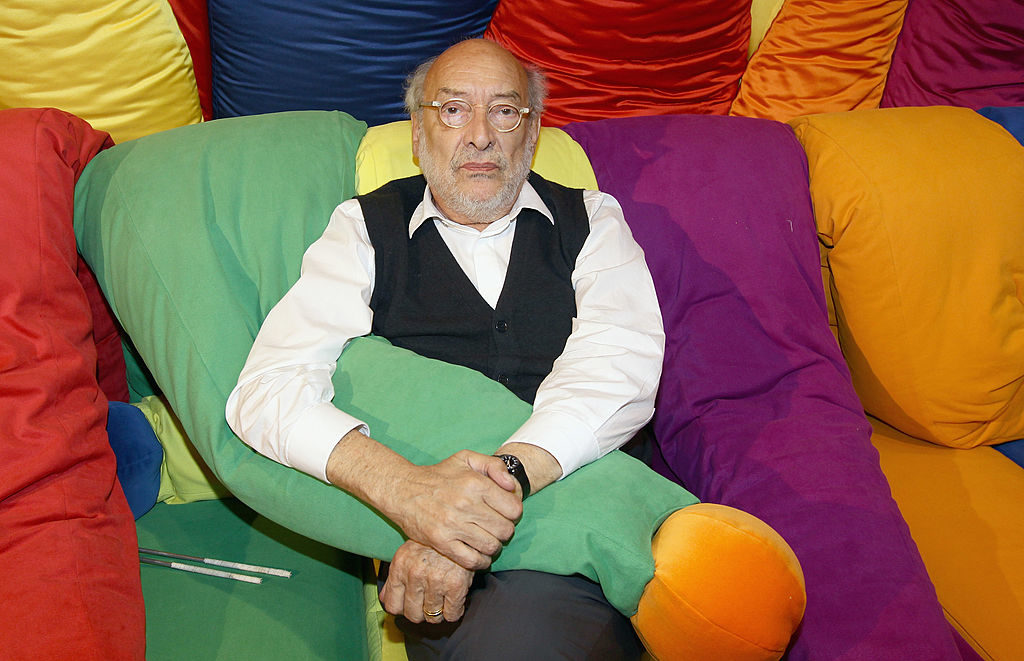
Rumors of his death were greatly exaggerated.

Eileen Kinsella

Gaetano Pesce’s exhibition in Florence, “Maestà Tradita” (or “Majesty Betrayed”), a three-part show with the main exhibition at Museo del Novecento and an installation in the Piazza Santa Maria Novella, was always expected to be a major event.
But perhaps not quite this major.
The show, which supposedly had the endorsement of the municipality of Florence, including the office of Mayor Dario Nardella, was scheduled to open on Friday October 21, including the unveiling of the work in the piazza. But when the artist fell ill and found himself unable to travel to Italy for the occasion, Mayor Nardella pulled the plug on the piazza unveiling and refused to proceed unless Pesce turned up, according to reports. Pesce interpreted this as a form of “blackmail,” according to La Stampa. The Novecento Museum show did go ahead as planned and Nardella even has an entry about it on his personal webpage.
Angered by the mayor’s actions, Pesce’s friend, Italian art critic Vittorio Sgarbi, took to social media on October 19, tweeting that the artist had taken a turn for the worse and died, in an effort to compel the mayor to unveil the work. Pesce’s office was immediately flooded with condolences, but no word from the mayor’s office, according to their account.
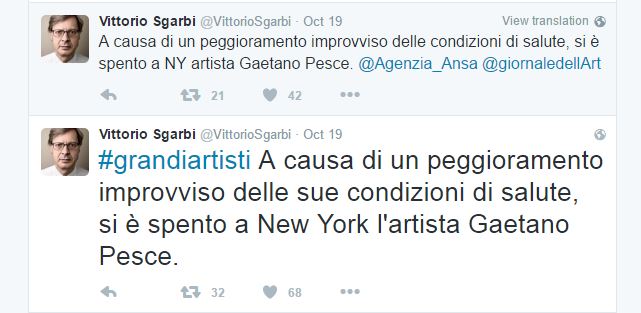
A few days later, Sgarbi next shared on social media that Pesce had been “resurrected” and was in fact, alive and well, even conducting an interview with him and asking questions about “the hereafter.”
According to the interview in La Stampa:
Interviewer: How do you like it in the Hereafter? Are there comfortable chairs like the ones you have designed?
Pesce: It is great and everything is comfortable but I am still here.
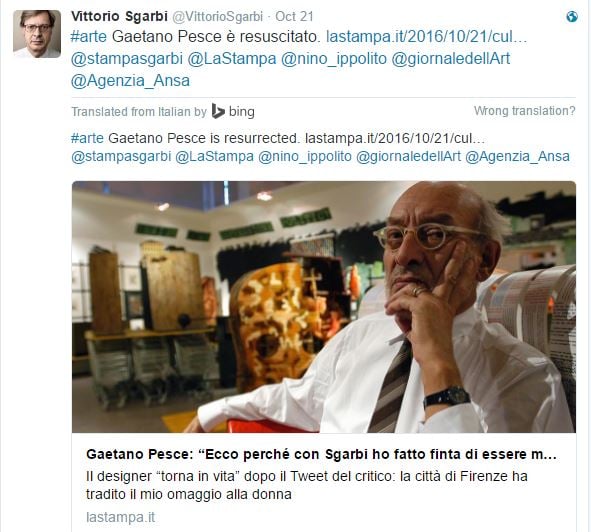
We couldn’t help but recall other instances of art world death fake-outs including that time in 2014 that “Zombie” Cy Twombly died a second time, or artist Adam McEwen’s eloquent but fake obituaries, especially the one on Jeff Koons that was part of the new Whitney Museum building opening show in 2015.
According to a spokesperson for Pesce, this sequence of events unfolded against an already strained relationship between the artist and Nardella’s office regarding an appropriate venue for the exhibition. Initial plans to install the show at the Palazzo Vecchio and Piazza della Signora respectively, were scrapped, when the subject matter, which deals with the oppression of women, was deemed unsuitable to sit alongside Renaissance sculptures of male figures. Pesce said it was a “Florentine journalist” who had expressed shock over the placement of the work that prompted Nardella to change his mind.
Mayor Nardella’s office did not respond to artnet News’ emails.
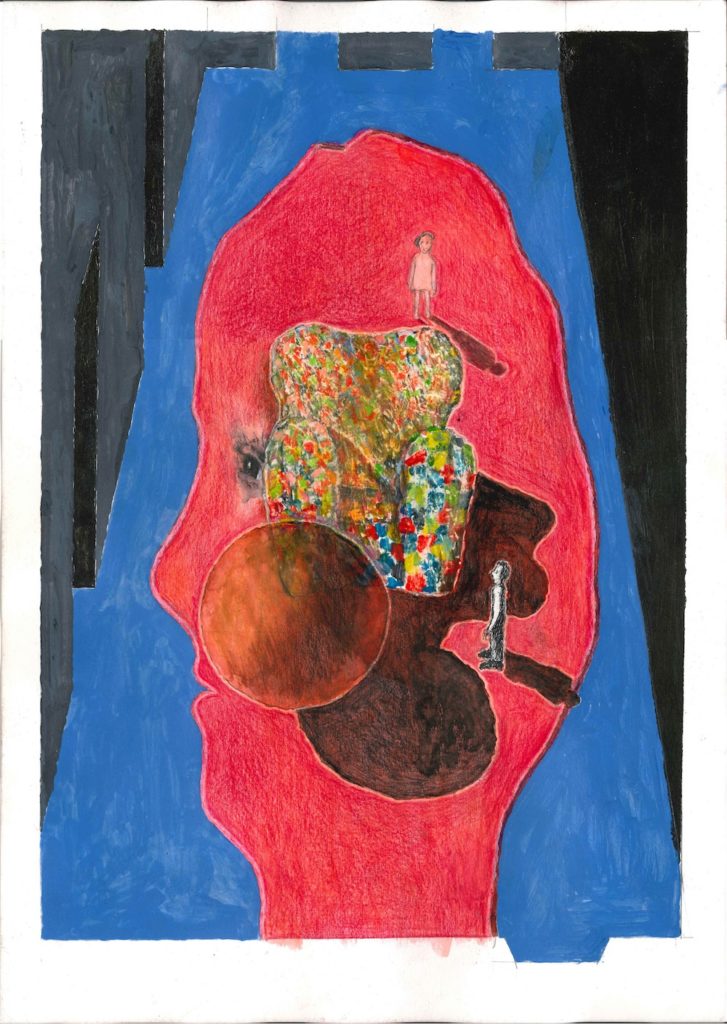
Gaetano Pesce Design for Museo del Novecento’s Large Gallery, 2016. Courtesy Gaetano Pesce’s Office.
artnet News corresponded with Pesce via email. Asked whether he was surprised that things turned contentious so quickly, Pesce said: “Yes, I was surprised because this decision was not punishing me, but my collaborators, the work, and the Florentine audience. Maesta’ Tradita being the bearer of a profound meaning of the injustice endured by women would have brought up many questions and a useful discussion. To reduce the impact of its absence I have decided to go to Florence in the next few days to install Maesta’ Tradita.”
Asked whether it had ever been a stipulation that he be present before the work was unveiled, Pesce responded “No, simply no.”
Asked why Sgarbi had made the false death claim, Pesce said: “Vittorio Sgarbi has suggested my death as it would take away the opportunity for the Mayor to say that Maesta’ Tradita would have been shown only upon my arrival to the city. Being myself deceased, my presence would have not been possible and the Mayor would have been forced to unveil the work immediately.”
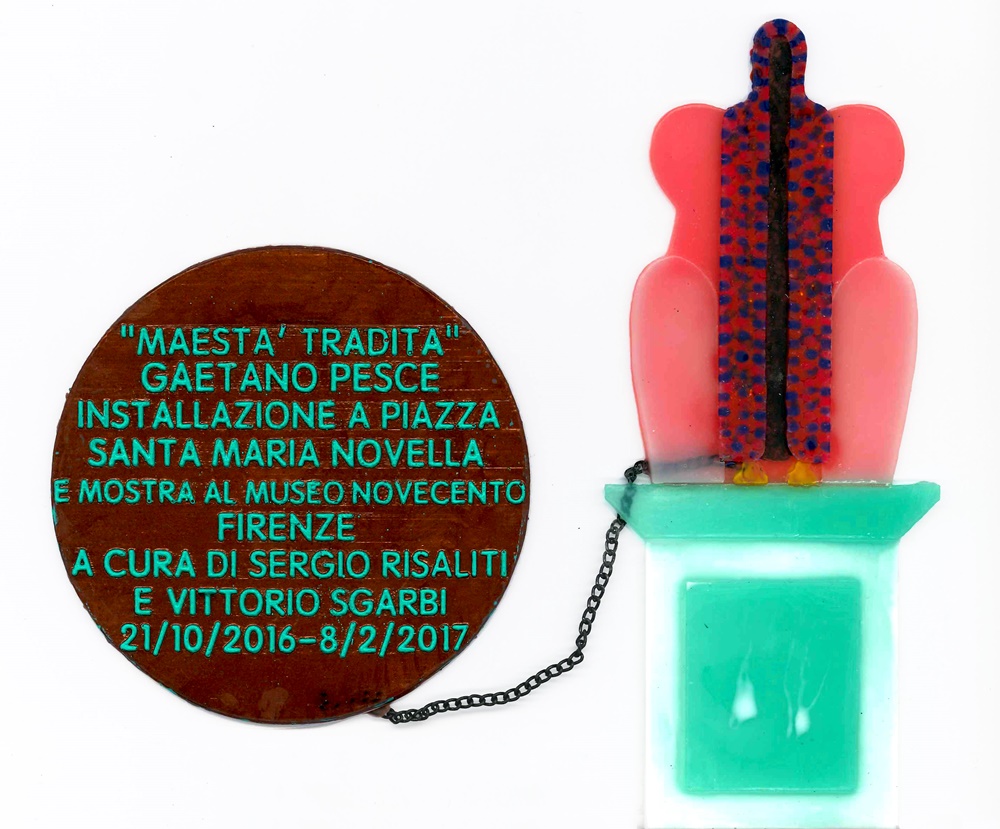
Gaetano Pesce Maestà Tradita Exhibition Announcement, 2016. Courtesy Gaetano Pesce’s Office.
As described in the press release, the monumental sculpture “represents a woman wrapped up in a long cloak: she is a sort of Mater Matuta (like the one at the Florence Archaeological Museum), and also an archtype inspired by the Christian Maestà.”
Discussing the museum show in his interview with Sgarbi, Pesce described what visitors will experience:
In the first room there is a huge chair with feminine clothes of different eras and styles. The floor appears to be a large patch of blood and has the shape of a female face. There are other armchairs covered in garments, to evoke the lack of freedom of women. The second room is dedicated to the five senses. This opens the taste of bitterness: a sequence of 18 tables, each on a plate, a piece of bread and a liquid similar to bile. At the entrance is a warning: if you try to dip the bread in the liquid you will understand the bitter morsels that women are forced to swallow every day. You will hear the lament of Kurdish women, which is from 1972 when I presented Tribute to Kurds which now is in a Montreal museum. The museum ushers will spray the smell of sweat that we ordered from a perfume maker to remember the hardships that women face daily. The fourth sense, vision, is the vision of the room and the fifth is the possibility of touching exposed things. Of course, the project is not complete without Majesty Betrayed, a great statue with woman’s body and cloak with the plagues that women now bear.
Asked whether anything this bizarre had ever happened in his career before, Pesce said:
In 1978 I was to have an exhibition at the Collegi of Arquitectes in Barcelona. The boxes containing the projects and the models to show had already arrived and so had my collaborators and my family. I had arrived as well. However, as the organizers opened the boxes and saw the model of the doorway with the naked butt, etc., they censored the exhibition and sent everything back to Paris where I resided at that time. On top of that they cancelled our hotel reservation in quite an unwelcoming way. It was the time when dictator Franco was still alive and therefore Spain was a country under fascist regime where there was a strong control and censorship over cultural life.